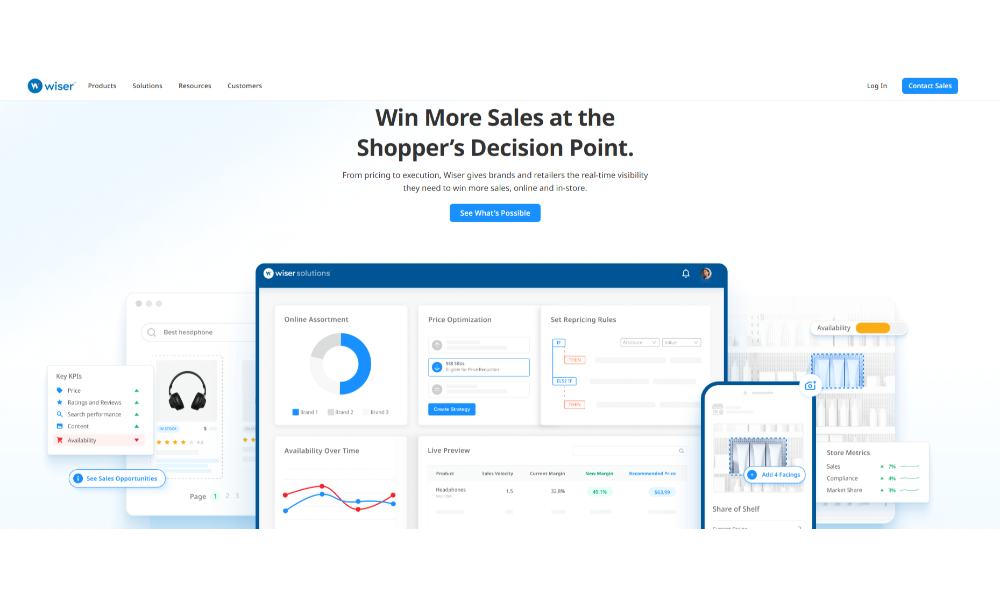MAP Pricing Policy: How to Protect Your Brand Value

If you’ve built a brand, you must understand that in the long run, it takes time to earn trust. You’ve spent months perfecting packaging, crafting content, running campaigns, and shaping customer experience only to see it all unravel because a reseller on Amazon dropped the price by 20% overnight.
It’s frustrating, but it’s also too common. One unauthorized listing can turn what you carefully positioned as a premium product into just another bargain option, and that’s when a MAP (minimum advertised pricing) policy becomes a shield for your brand.
Moreover, MAP isn’t about controlling prices for the sake of control. It’s about ensuring consistency, protecting margins, and safeguarding the credibility you’ve worked hard to build.
In today’s e-commerce world, where marketplaces are fragmented and AI-driven repricing tools react in real time, you need policies that don’t just look good on paper but actively preserve your brand’s value.
What Is a MAP Pricing Policy?
A Minimum Advertised Price (MAP) policy is essentially the boundary a brand sets on how low a reseller can promote a product’s price in public spaces, whether that’s on Amazon, your own website, a Google ad, or even a printed catalog.
It’s important to understand that MAP doesn’t control the actual sale price; however, it takes charge of how low you can advertise that price.
In other words, brands are saying, “You’re free to negotiate privately or offer discounts behind closed doors, but when it comes to marketing your product, keep it above this minimum.”
For example, if the MAP for a product is set at $50, a reseller cannot advertise it at $49.99 even if they’re eager to clear out inventory or outcompete another seller. Violating this guideline doesn’t just affect margins; it weakens the brand’s perceived value and trustworthiness, which is why most companies enforce MAP rigorously.
The whole concept behind MAP emerged to prevent uncontrolled price wars. Without it, resellers would constantly undercut each other, especially against the Manufacturer’s Suggested Retail Price (MSRP), which could spiral into chaotic discounting that erodes a product’s premium appeal.
When implemented thoughtfully, MAP benefits everyone involved. It stabilizes prices, helps maintain brand integrity, and ensures resellers can protect their margins without getting dragged into destructive price competition. But it’s not a “set it and forget it” tool; brands must invest time and resources into drafting clear guidelines and enforcing them consistently.
In the sections ahead, we’ll explore how this plays out specifically on Amazon, where pricing dynamics are fast-moving and competition is fierce, and how a well-crafted MAP strategy can be the difference between sustainable growth and margin collapse.
MAP vs. MSRP vs. Resale Price Maintenance (RPM)
Knowing the difference between MAP, MSRP, and RPM is crucial because it helps you set the right pricing rules without risking legal trouble. It is about protecting your brand and building trust while staying compliant.
MSRP (Manufacturer’s Suggested Retail Price)
This is just a suggestion. Think of it as a polite offer from the brand: “Here’s what we think this should sell for.” Retailers are free to go higher or lower.
MAP (Minimum Advertised Price)
This is enforceable. It’s not about dictating the actual sale price but about drawing a line in how your brand is positioned publicly. If your MAP is $100, no retailer can advertise your product at $99, even if they want to sell it for less in private.
Resale Price Maintenance (RPM)
This is the hot potato. RPM is when a manufacturer outright controls the final sale price, not just the advertised one. That crosses into antitrust territory in many countries (especially in the EU/UK) and can get brands into legal trouble.
Common Myths Around MAP
MAP pricing is one of those topics surrounded by half-truths and misconceptions. Some sellers assume it’s illegal, others fear it stifles competition, and many think it can’t be enforced on Amazon.
In reality, most of these myths are outdated, and clearing them up is key to understanding how MAP really works today.
MAP is illegal
Nope. MAP policies, when written and enforced correctly, are perfectly legal in the U.S. They fall under what’s called the Colgate Doctrine: brands can set unilateral conditions for doing business with resellers. What’s illegal is working together with retailers to control the final sale price; that’s known as resale price maintenance, or RPM, and it’s against the law
MAP kills competition
The opposite, actually. MAP creates a fair playing field. Without it, rogue sellers who slash prices with no regard for margins would dominate, pushing out compliant retailers who can’t compete.
Over time, that erodes choice for consumers. MAP ensures competition happens on service, content, and customer experience, not just on who can discount the fastest.
MAP only benefits big brands
In reality, MAP can be even more important for small and mid-sized brands.
If you’re trying to build a premium reputation on Amazon or Walmart Marketplace, one seller undercutting you by 20% can undo years of positioning.
MAP protects your investment in branding, not just your margins.
Why MAP is Important in 2025
A few years ago, MAP wasn’t seen as the best practice. Now, it’s become a full-time survival strategy. The ecommerce landscape has shifted so quickly that brands without a strong MAP pricing policy have lower margins, lose control of their listings, and watch customer trust erode overnight.
Here’s why it matters more:
1. Price Monitoring Tools Are Now Essential
Back in 2020, only a handful of brands had formal MAP monitoring programs. Fast forward to 2025, and over 70% of brands now use AI-driven MAP monitoring tools to keep resellers in check.
Platforms like Wiser, TrackStreet, and PriceSpider scrape marketplaces like Amazon, Walmart Marketplace, and even TikTok Shop in real time.
That means violations are not only easier to detect, they’re also impossible to ignore. If a seller dips below MAP, you’ll know instantly. And if you don’t act, your resellers will notice the inconsistency and lose faith in your enforcement.
2. Marketplaces Move Faster
The rise of Amazon, Walmart Marketplace, and TikTok Shop has made discounting nearly instantaneous.
A rogue seller on Amazon drops the price, a Walmart seller matches it, and by the end of the day, your product is circulating on TikTok Shop at 15% below MAP.
Most resellers now run repricing bots that constantly scan competitor listings. One MAP violation doesn’t stay isolated; it triggers a chain reaction that drags everyone else down.
3. MAP Violations Are Global Now
MAP used to be a domestic problem, something you managed inside one market. In 2025, global distribution chains mean violations can appear anywhere.
This indicates that an unauthorized distributor in Europe might be funneling excess inventory into the U.S. Amazon marketplace. A reseller in Southeast Asia lists your product for half the price on TikTok Shop, undercutting local pricing.
Cross-border arbitrage confuses the customers, which makes them think, “Why pay more when the same product is available elsewhere for less?”
Without MAP enforcement across geographies, your carefully built brand equity doesn’t stand a chance.
4. AI Price Scraping
The irony of 2025 is that AI-driven price scraping has made MAP enforcement both easier and harder. On one hand, AI tools flag violations instantly, documenting evidence you can use against unauthorized sellers.
On the other hand, those same AI bots are being used by resellers to spot and exploit gaps faster than humans ever could.
Additionally, the MAP violations don’t just happen; they are multiplied. A single discount in one corner of the web can cascade into dozens of listings within hours.
Navigating the Legal Landscape for Sellers
In the U.S., MAP remains squarely in the legal landscape as long as it’s framed as a unilateral policy created and enforced by the manufacturer, not negotiated with resellers. This structure helps brands avoid running afoul of antitrust rules.
That said, if a platform’s design makes it practically impossible to offer discounts below MAP (like through cart-based pricing locks), it may be considered a form of Resale Price Maintenance (RPM), which is more legally risky.
So in your MAP pricing policy, clarity should be everything. Document your business rationale, brand protection, and margin integrity, and enforce it consistently across all channels.
Why Enforcing MAP in Europe/UK Is More Complicated Than You Think
Across the pond, things look very different. In both the EU and the UK, MAP pricing policies are often considered anti-competitive, putting them in legal danger. Brands using MAP in these regions risk regulatory scrutiny or outright penalties.
Instead, what’s trending in 2025 is selective distribution, limiting which sellers can carry your products and enforcing strict criteria like authorized seller lists rather than explicitly controlling advertised pricing.
Latest Update: Modern Legal Requirements Around MAP Enforcement
While region-specific rulings around MAP are rare, the shifting legal boundaries are playing out in courts and policy debates:
1. In the U.S., the line between advertised pricing (MAP) and actual sale price (RPM) is being refined, particularly when online checkout mechanics make it impossible to offer “below MAP” prices.
2. In the EU, regulators are leveraging precedents around territorial supply constraints, emphasizing that pricing controls that hamper cross-border trade run counter to single-market principles.
Recent enforcement actions (like big chunks of fines for cross-border restrictions imposed by Mondelēz and AB InBev) are raising the bar on what’s acceptable.
Why It Matters for Your MAP Pricing Strategy
If you’re operating in the U.S. or Canada, you’re on legally solid ground. Just don’t negotiate your policy with resellers, and keep enforcement impartial and well-documented. That’s how you stay within the Colgate Doctrine framework.
The Colgate Doctrine, stemming from a U.S. Supreme Court ruling, allows brands to set a MAP pricing policy as long as they unilaterally choose their terms without negotiating or conspiring with resellers.
In simpler terms, it means you can tell resellers, “This is our advertised price; follow it or we’ll stop doing business with you,” but you can’t collaborate with them on pricing strategies or enforce rules that resemble resale price maintenance (RPM), which would be illegal.
So while you’re operating in the U.S. or Canada, this framework gives you legal protection, provides you with the ability to enforce MAP consistently and fairly, and avoids any appearance of collusion. That’s why keeping enforcement impartial, transparent, and well-documented is important so that every violation must be handled according to the policy.
But in the EU/UK markets, you have to be more careful. MAP could expose you to antitrust risk. Focus on controlling who sells your products, not how they advertise them.
And in 2025, evolving e-commerce features like rigid “see price in cart” mechanisms can blur the line between permissible policy and resale price maintenance (RPM)-style enforcement, so stay alert to platform design changes.
MAP Enforcement in Practice
Writing and enforcing a MAP pricing policy are two sides of the same coin. By now, enforcement will be less about issuing threats and more about balancing relationships with resellers while protecting your brand from them.
Brands that succeed treat enforcement like a partnership strategy rather than a price war.
The Carrot Approach
The most effective brands now view MAP compliance as a tiered privilege system rather than a baseline requirement. Instead of handing out generic perks, they make compliance feel like a competitive advantage.
Compliant sellers are often rewarded with early access to new product launches or limited-edition SKUs, a privilege that immediately boosts their sales potential.
Some brands go further by sharing exclusive data market insights, keyword analytics, and performance reports that help resellers make smarter decisions and improve margins. Others create cross-channel opportunities, offering better shelf placements in retail, joint marketing campaigns, or even introductions to B2B buyers. In this model, MAP is no longer a burden but a growth lever, something sellers actively strive to maintain in order to stay in the brand’s inner circle.
The Stick Approach
Incentives keep good sellers aligned. The strongest brands today have moved away from slow, reactive enforcement and now rely on AI-driven MAP monitoring tools that flag violations within hours. Once flagged, violations follow a documented escalation path that is a warning first, then temporary suspension, and finally permanent delisting for persistent offenders.
This consistency not only feels fair but also creates a sense of inevitability once you cross the line; consequences follow quickly. Brands are also pushing accountability upstream, requiring distributors to police their networks and cutting off supply if they fail to do so. And in cases where damage is more severe, legal takedowns and Amazon Brand Registry escalations are used as visible warnings to others.
Every delay in enforcement signals weakness, and every swift action reinforces that MAP is not negotiable.
The real insight here is that the carrot approach builds loyalty, while the stick preserves equity. A brand that leans too heavily on punishment risks alienating its best sellers, while one that relies only on perks risks exploitation. The balance of both is what creates a culture of compliance, where sellers don’t just follow MAP because they have to; they follow it because it benefits them and because they know the rules are enforced without hesitation.
MAP Enforcement in Action
Take a premium outdoor gear brand in 2024-25. They noticed consistent MAP violations on Amazon: resellers were undercutting their $250 MAP price by $40, dragging down Buy Box margins.
Here’s what they did:
1. Identified violators with AI monitoring tools.
2. Cut supply leaks by tightening distributor agreements.
3. Offered compliant resellers ad co-op funding and better wholesale pricing.
4. Terminated repeat offenders and sent formal notices.
Within six months, the brand reported a 22% increase in premium channel sales while also regaining price consistency across Amazon, Walmart Marketplace, and specialty retailers.
The key wasn’t just punishment; it was creating an ecosystem where compliance paid better than undercutting.
Amazon and Marketplace Enforcement Challenges
This is where things get confusing. Amazon doesn’t enforce your MAP pricing policy for you. If anything, Amazon’s system rewards the lowest price with the Buy Box, which makes violations even more tempting.
So brands have to take matters into their own hands, using a mix of Amazon-native tools and strategic controls:
Amazon Brand Registry
Many brands think of it as just a reporting tool, but when used correctly, it becomes the foundation of your listing protection. It allows you to take ownership of your product’s content titles, images, and descriptions, which makes it harder for unauthorized sellers to hijack your listing or misrepresent the product.
Beyond just reporting violations, Brand Registry helps you establish workflows for resolving issues, keeping clear documentation, and ensuring that enforcement actions are applied consistently. A brand that audits its listings regularly is far better prepared to prevent pricing violations than one that only reacts after a problem arises.
Amazon Transparency Codes
With serialization, you can trace each product unit across borders, making it possible to uncover diversion networks before they reach marketplaces.
You’re able to see patterns in cross-border activity, perhaps a distributor in Europe is quietly offloading stock into U.S. channels, and intervene before unauthorized sellers flood marketplaces. More importantly, serialization builds trust with customers.
When shoppers scan a code and see that a product is verified as authentic, they’re less likely to chase discounts elsewhere. Treat serialization as a way to audit your distribution network and strengthen customer relationships, not just another compliance checkbox
Authorized Reseller Programs
By clearly listing approved sellers, brands offer customers an easy way to identify trustworthy sources. This creates peer pressure within the ecosystem; once shoppers recognize who’s authorized, they’re less likely to buy from sellers offering deep discounts that could hurt the brand’s reputation.
More than that, authorized reseller lists allow brands to control distribution without micromanaging prices.
Instead of policing every listing, you’re shaping the market’s behavior by signaling where trust lies. Educating customers on why authorized sellers matter transforms compliance into a shared responsibility rather than just a forced rule.
Marketplace Watchdogs
Tools like TrackStreet, Wiser, and MAPP Trap integrate with Amazon to flag MAP violations in real time.
Today, AI repricing bots on Amazon don’t care about your MAP policy. Once one seller drops below MAP, bots drag everyone else down in hours. That’s why proactive monitoring, strict distribution controls, and carrot-and-stick enforcement aren’t optional anymore; they’re the only way to preserve brand value.
How to create a MAP Policy
Most MAP pricing policies fail not because the rules are unclear, but because the tone is wrong. Too often, brands treat MAP like a “cease-and-desist” letter instead of a long-term partnership framework.
Now, the brands that win are the ones that treat their resellers like allies in protecting brand equity, not like potential criminals waiting to break the rules.
Writing a MAP Policy That Doesn’t Read Like a Threat Letter
The old-school MAP documents were stiff, legally heavy, and often dropped like a bomb on distributors: “Comply or lose your account.” That tone breeds resentment, not compliance.
A modern MAP pricing policy should:
Frame compliance as a win-win: “This protects your margin as much as ours.”
Speak in plain English: Resellers don’t need a wall of legal jargon; they need clarity.
Highlight the benefits of compliance: Access to co-op marketing funds, better wholesale pricing, and faster replenishment.
Make enforcement predictable: Lay out exactly what happens after the first, second, and third violations.
Internal Alignment
Also, it’s not always resellers who break MAP first; it’s your own sales team. A salesperson chasing quarterly targets might quietly give a distributor extra margin or look the other way when MAP is violated, just to secure a big order.
The problem is that short-term wins create long-term chaos. One leaked batch of discounted product is all it takes for rogue sellers to start undercutting everyone on Amazon.
To fix this, MAP needs internal buy-in:
- Train your sales reps to see MAP as brand equity insurance, not a sales blocker.
- Tie compliance to sales incentives; reward reps who keep their accounts clean.
- Share monitoring data internally so everyone sees the real cost of MAP violations.
MAP Monitoring & Tech Today
A few years ago, enforcing a MAP pricing policy meant interns and junior staffers combing through websites, spreadsheets in hand, looking for violations. In 2025, that sounds almost laughable. The sheer speed and complexity of online marketplaces have made AI-driven MAP monitoring tools and automation not just helpful, but essential.
How AI and Automation Have Changed MAP Monitoring
Today, MAP enforcement runs at machine speed.
1. AI-powered systems scrape millions of listings across Amazon, Walmart Marketplace, TikTok Shop, and DTC sites in real time.
2. Instead of reacting to violations days later, brands now get instant alerts when a reseller dips below MAP.
3. Some platforms even use predictive analytics, flagging resellers likely to break policy based on past behavior, seasonal patterns, or unusual inventory volumes.
This shift has turned MAP from a reactive compliance headache into a proactive brand control strategy.
Real-Time MAP Monitoring Tools
Now, adoption is mainstream, with over 70% of brands relying on dedicated MAP monitoring platforms. Popular tools like TrackStreet, Wiser, PriceSpider, MAPP Trap, and 42Signals integrate directly with marketplaces, feeding brands’ dashboards full of actionable data.

What they offer:
1. Automated violation tracking with screenshot evidence.
2. Seller identification linking violations back to distributors or unauthorized resellers.
3. Enforcement workflows that automatically send notices or escalate penalties.
OtterBox, the well-known phone case brand, dramatically transformed its MAP enforcement by partnering with Wiser.

Once they implemented Wiser’s real-time monitoring solution, OtterBox gained a centralized dashboard to spot violations, capture screenshots as evidence, and identify unauthorized sellers. This not only streamlined enforcement but also cut counterfeit-related support costs and preserved their premium brand image
How Blockchain and Serialization Help You Protect Your Brand and Keep Pricing Fair
MAP violations usually start with a leak. A distributor offloads excess stock, or inventory slips into gray-market channels. By the time it shows up on Amazon, it’s too late.
That’s why forward-looking brands in 2025 are pairing MAP with blockchain and serialization technologies:
- Blockchain ledgers create tamper-proof records of every unit’s journey through the supply chain.
- Serialization (unique product codes or Amazon Transparency codes) lets brands trace rogue inventory back to its source in seconds.
Understanding Consumer Psychology: What is Inside Your Buyer’s Mind?
MAP enforcement isn’t just about margins; it’s about trust. When a shopper sees your $200 product listed for $139 on Amazon, $149 on Walmart, and $199 on your own DTC store, they don’t think, “Great, deals everywhere!” They think, “Wait, which price is real? Is this product even legit?”
Inconsistent pricing signals chaos. And chaos erodes brand credibility faster than any ad campaign can rebuild it. A MAP pricing policy on Amazon and beyond isn’t just a compliance mechanism; it’s a psychological anchor that reassures customers your brand is stable, authentic, and worth the price you’re asking.
Final thoughts
At the end of the day, a MAP pricing policy isn’t just a legal safeguard or a margin-protection strategy; it’s a statement about your brand. In 2025, marketplaces like Amazon, Walmart, and TikTok Shop have leveled the playing field in ways that are both exhilarating and brutal.
Without clear guardrails, your product can be devalued overnight by a rogue reseller, and once trust erodes, it’s nearly impossible to buy it back with ad spend.
The brands winning today don’t treat Amazon MAP pricing as a checkbox exercise. They integrate MAP into every layer of their business, from how sales teams negotiate with distributors to how AI-driven monitoring tools flag violations in real time.
They know enforcement isn’t just the stick; it’s also the carrot: rewarding partners who play by the rules with better terms, visibility, and support.
So whether you’re drafting your first MAP policy or rethinking how to enforce MAP on Amazon and other marketplaces, think beyond compliance. Think strategy. Think trust. In 2025, that’s what separates the brands that scale from the ones that disappear into the noise.
Read More:
Amazon Pricing Strategy to Maximize Sales and Ensure Steady Profitability
What is Amazon PPC? How the Amazon PPC Auction Works





![Buy Now, Pay Later [BNPL]: How E-commerce Brands are Revolutionizing Payments 7 What is Buy Now Pay Later for E-commerce](https://www.sellerapp.com/blog/wp-content/uploads/2023/02/buy-now-pay-later.jpg)




Michael Inpum
November 15, 2025I appreciate the clarity in this post. Many sellers overlook the legal and relationship impact of breaking MAP rules—this helped a lot.
Mariah Dalton
November 15, 2025This article adds real value. Understanding MAP policies has helped us reduce price wars in our marketplace listings.
Preston Hale
November 16, 2025Simple explanation for a complex topic. MAP compliance tools can be overwhelming, but you summarized them nicely.
Samuel Hox
November 16, 2025Great reminder to monitor unauthorized sellers. We’ve had issues with rogue discounts, so this really hits home.
Daniel Exits
November 16, 2025Thanks for highlighting the benefits for sellers. Most articles focus only on brands, but this shows how sellers benefit too.
Owen Cartwright
November 16, 2025Well written and structured. The differences between MAP, MSRP, and price floors were especially useful.
Elise Morgan
November 16, 2025This is exactly what I was looking for. MAP enforcement has always been tricky for us, and this guide gives practical direction.
Mira Chandler
November 17, 2025Loved the examples! Real-world scenarios make it easier to understand how MAP violations impact brand reputation.
Darian Webb
November 17, 2025Very informative article. MAP policies often confuse new sellers, but your explanation makes it so much clearer.
Quincy Turner
November 17, 2025Great breakdown of MAP pricing! This really helps brands understand why consistent pricing matters when selling through multiple retailers.